Mechanical Characterization of Hybrid Steel Wire Mesh/Basalt/Epoxy Fiber-Reinforced Polymer Composite Laminates
Abstract
:1. Introduction
2. Experimental Procedure
2.1. Materials
2.2. Specimen Fabrication
2.3. Material Characterization Process
2.3.1. Tensile Test
2.3.2. Compression Test
2.3.3. Shear Test
2.3.4. Flexural Test
3. Numerical Model
3.1. Initial Finite Element Model
3.2. Finite Element Model for Flexural Testing
3.2.1. FE Model Definition
3.2.2. Damage Initiation and Failure Criteria
4. Results and Discussion
4.1. Tensile Behavior
4.2. Compression Test
4.3. Shear Test
4.4. Flexural Test
4.5. Flexural Behavior of Hybrid Laminate Composite
4.5.1. Effect of Stacking Sequences on the Load–Displacement Curve
4.5.2. Effect of Stacking Sequences on the Flexural Responses
4.5.3. Design Factor Effects on the Structural Responses
4.5.4. Failure Mode Analysis
5. Conclusions
Author Contributions
Funding
Data Availability Statement
Acknowledgments
Conflicts of Interest
References
- Correia, J.R. Fibre-reinforced polymer (FRP) composites. In Materials for Construction and Civil Engineering: Science, Processing, and Design; Springer: Berlin, Germany, 2015; pp. 501–556. [Google Scholar]
- Keya, K.N.; Kona, N.A.; Koly, F.A.; Maraz, K.M.; Islam, N.; Khan, R.A. Natural fiber reinforced polymer composites: History, types, advantages and applications. Mater. Eng. Res. 2019, 1, 69–85. [Google Scholar] [CrossRef]
- Mlýnek, J.; Koloor, S.S.R.; Martinec, T.; Petrů, M. Fabrication of High-Quality Straight-Line Polymer Composite Frame with Different Radius Parts Using Fiber Winding Process. Polymers 2021, 13, 497. [Google Scholar] [CrossRef]
- Diniță, A.; Ripeanu, R.G.; Ilincă, C.N.; Cursaru, D.; Matei, D.; Naim, R.I.; Tănase, M.; Portoacă, A.I. Advancements in Fiber-Reinforced Polymer Composites: A Comprehensive Analysis. Polymers 2023, 16, 2. [Google Scholar] [CrossRef]
- Sun, G.; Chen, D.; Zhu, G.; Li, Q. Lightweight hybrid materials and structures for energy absorption: A state-of-the-art review and outlook. Thin-Walled Struct. 2022, 172, 108760. [Google Scholar] [CrossRef]
- Shah, I.A.; Badshah, S.; Ahmad, S.; Amjad, M.; Koloor, S.R.; Petru, M.; Khan, R. Finite element analysis of the ballistic impact on auxetic sandwich composite human body armor. Materials 2022, 15, 2064. [Google Scholar] [CrossRef]
- Van de Werken, N.; Tekinalp, H.; Khanbolouki, P.; Ozcan, S.; Williams, A.; Tehrani, M. Additively manufactured carbon fiber-reinforced composites: State of the art and perspective. Addit. Manuf. 2020, 31, 100962. [Google Scholar] [CrossRef]
- Wang, B.; Gao, H. Fibre reinforced polymer composites. In Advances in Machining of Composite Materials: Conventional and Non-Conventional Processes; Springer: Berlin, Germany, 2021; pp. 15–43. [Google Scholar]
- Seffo, M.; Hamcho, M. Strength of Concrete Cylinder Confined by Composite Materials (CFRP). Energy Procedia 2012, 19, 276–285. [Google Scholar] [CrossRef]
- Ortiz, J.D.; Dolati, S.S.K.; Malla, P.; Nanni, A.; Mehrabi, A. FRP-reinforced/strengthened concrete: State-of-the-art review on durability and mechanical effects. Materials 2023, 16, 1990. [Google Scholar] [CrossRef]
- Feng, G.; Zhu, D.; Guo, S.; Rahman, Z.; Jin, Z.; Shi, C. A review on mechanical properties and deterioration mechanisms of FRP bars under severe environmental and loading conditions. Cem. Concr. Compos. 2022, 134, 104758. [Google Scholar] [CrossRef]
- Arora, S.; Chitkara, R.; Dhangar, A.S.; Dubey, D.; Kumar, R.; Gupta, A. A review of fatigue behavior of FRP composites. Mater. Today Proc. 2022, 64, 1272–1275. [Google Scholar] [CrossRef]
- Chavhan, G.R.; Wankhade, L.N. Improvement of the mechanical properties of hybrid composites prepared by fibers, fiber-metals, and nano-filler particles–A review. Mater. Today Proc. 2020, 27, 72–82. [Google Scholar] [CrossRef]
- Sun, G.; Tong, S.; Chen, D.; Gong, Z.; Li, Q. Mechanical properties of hybrid composites reinforced by carbon and basalt fibers. Int. J. Mech. Sci. 2018, 148, 636–651. [Google Scholar] [CrossRef]
- Sanjay, M.A.; Yogesha, B. Studies on mechanical properties of jute/E-glass fiber reinforced epoxy hybrid composites. J. Miner. Mater. Charact. Eng. 2016, 4, 15–25. [Google Scholar] [CrossRef]
- Nejad, A.F.; Bin Salim, M.Y.; Koloor, S.S.R.; Petrik, S.; Yahya, M.Y.; Abu Hassan, S.; Shah, M.K.M. Hybrid and synthetic FRP composites under different strain rates: A review. Polymers 2021, 13, 3400. [Google Scholar] [CrossRef] [PubMed]
- Subagia, I.A.; Sutantra, N.; Kim, Y.J. Influences Stacking of Basalt-Glass Fabrics Reinforced Epoxy Matrix Hybrid Composites towards Tension Loads. Key Eng. Mater. 2023, 941, 225–231. [Google Scholar] [CrossRef]
- Satish, K.; Siddeswarappa, B.; Kaleemulla, K.M. Characterization of in-plane mechanical properties of laminated hybrid composites. J. Miner. Mater. Charact. Eng. 2010, 9, 105. [Google Scholar] [CrossRef]
- Carrillo, J.; Cantwell, W. Mechanical properties of a novel fiber–metal laminate based on a polypropylene composite. Mech. Mater. 2009, 41, 828–838. [Google Scholar] [CrossRef]
- Gonzalez-Canche, N.; Flores-Johnson, E.; Carrillo, J. Mechanical characterization of fiber metal laminate based on aramid fiber reinforced polypropylene. Compos. Struct. 2017, 172, 259–266. [Google Scholar] [CrossRef]
- Truong, G.T.; Choi, K.-K. Tensile behavior of hybrid composites of carbon fibers—Steel wire mesh reinforced polymer. Mech. Adv. Mater. Struct. 2021, 28, 154–166. [Google Scholar] [CrossRef]
- Salve, A.; Mache, A. Effect of metallic reinforcement on the mechanical behaviour of a hybrid polymer composite—A review. Mater. Today Proc. 2023, 10, 2200900. [Google Scholar] [CrossRef]
- Nag, M.K.; Kumar, P. Fabrication and characterization of laminated natural fibers and SS303 wire mesh reinforced epoxy-based hybrid composite. Proc. Inst. Mech. Eng. Part L J. Mater. Des. Appl. 2024, 238, 73–99. [Google Scholar] [CrossRef]
- Megahed, A.; El-Wadoud, F.A.; Wagih, A.; Kabeel, A.M. Effect of incorporating aluminum wire mesh on the notched and un-notched strengths of glass fiber/epoxy composites. Compos. Struct. 2021, 263, 113695. [Google Scholar] [CrossRef]
- Pazhanivel, K.; Bhaskar, G.; Elayaperumal, A. Significance of stainless steel wire reinforcement on the mechanical properties of GFRP composites. Int. J. Eng. Technol. 2014, 6, 178–182. [Google Scholar]
- Karunagaran, N.; Rajadurai, A. Effect of surface treatment on mechanical properties of glass fiber/stainless steel wire mesh reinforced epoxy hybrid composites. J. Mech. Sci. Technol. 2016, 30, 2475–2482. [Google Scholar] [CrossRef]
- Nejad, A.F.; Koloor, S.S.R.; Arifin, M.L.H.; Shafiei, A.; Abu Hassan, S.; Yahya, M.Y. Crashworthiness assessment of carbon/glass epoxy hybrid composite tubes subjected to axial loads. Polymers 2022, 14, 4083. [Google Scholar] [CrossRef] [PubMed]
- Committee, D. Test Method for Tensile Properties of Polymer Matrix Composite Materials; ASTM International: West Conshohocken, PA, USA, 2014. [Google Scholar]
- ASTM D7264; Standard Test Method for Flexural Properties of Polymer Matrix Composite Materials. ASTM International: West Conshohocken, PA, USA, 2007.
- Koloor, S.S.R.; Karimzadeh, A.; Abdullah, M.R.; Petrů, M.; Yidris, N.; Sapuan, S.M.; Tamin, M.N. Linear-nonlinear stiffness responses of carbon fiber-reinforced polymer composite materials and structures: A numerical study. Polymers 2021, 13, 344. [Google Scholar] [CrossRef] [PubMed]
- Adams, D.O.; Moriarty, J.M.; Gallegos, A.M.; Adams, D.F. The V-notched rail shear test. J. Compos. Mater. 2007, 41, 281–297. [Google Scholar] [CrossRef]
- Nia, A.B.; Nejad, A.F.; Xin, L.; Ayob, A.; Yahya, M.Y. Energy absorption assessment of conical composite structures subjected to quasi-static loading through optimization based method. Mech. Ind. 2020, 21, 113. [Google Scholar] [CrossRef]



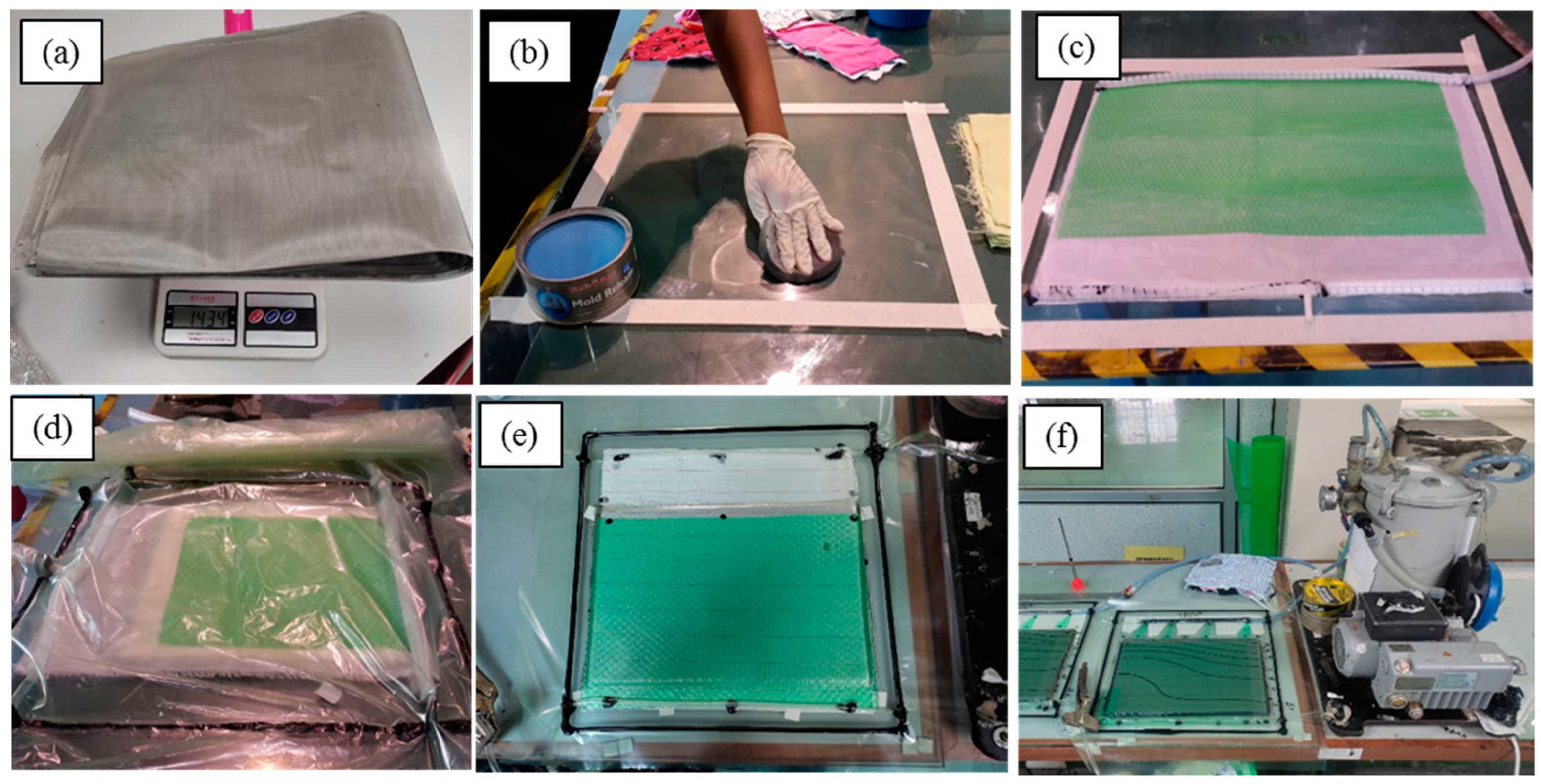


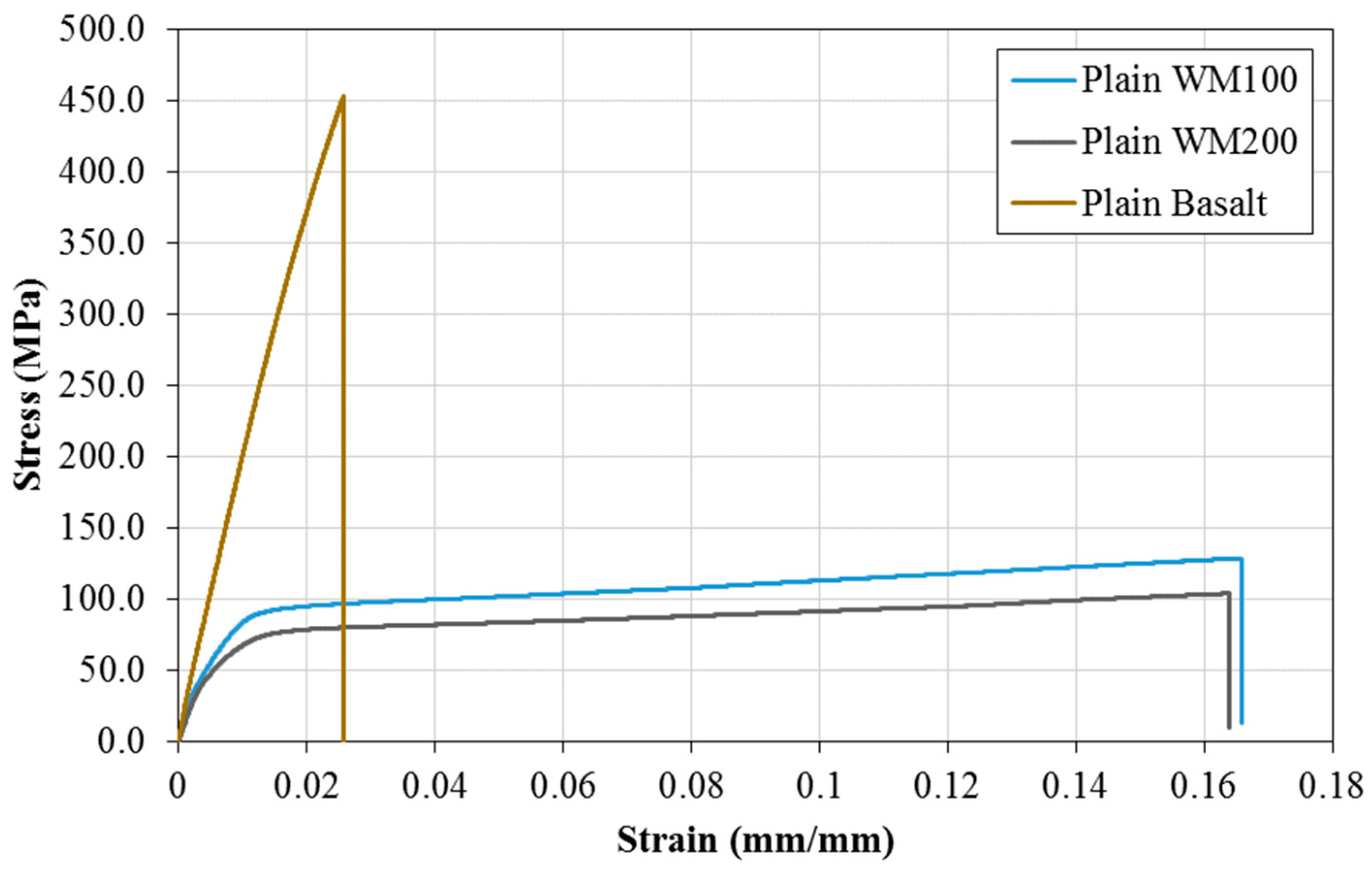

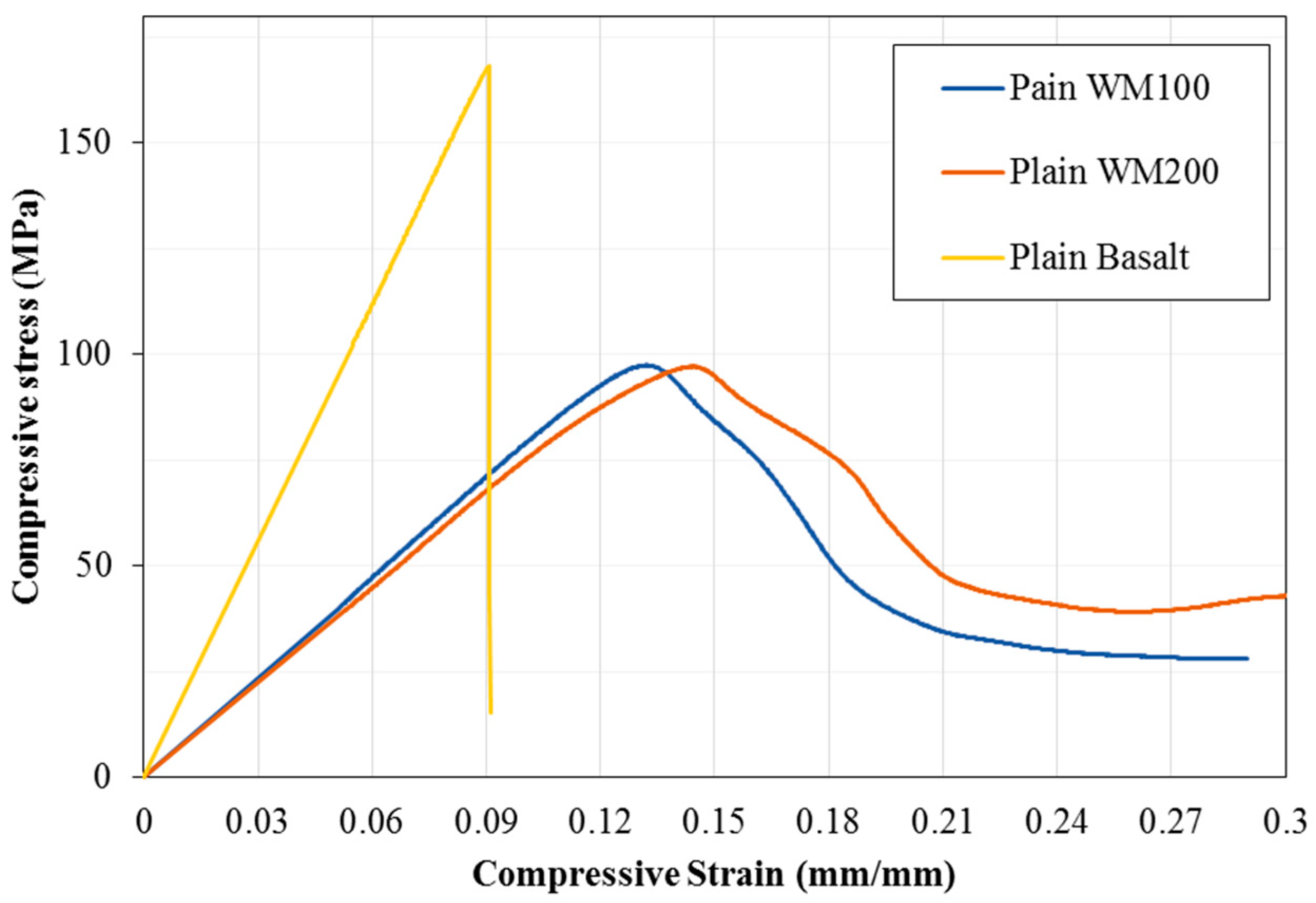





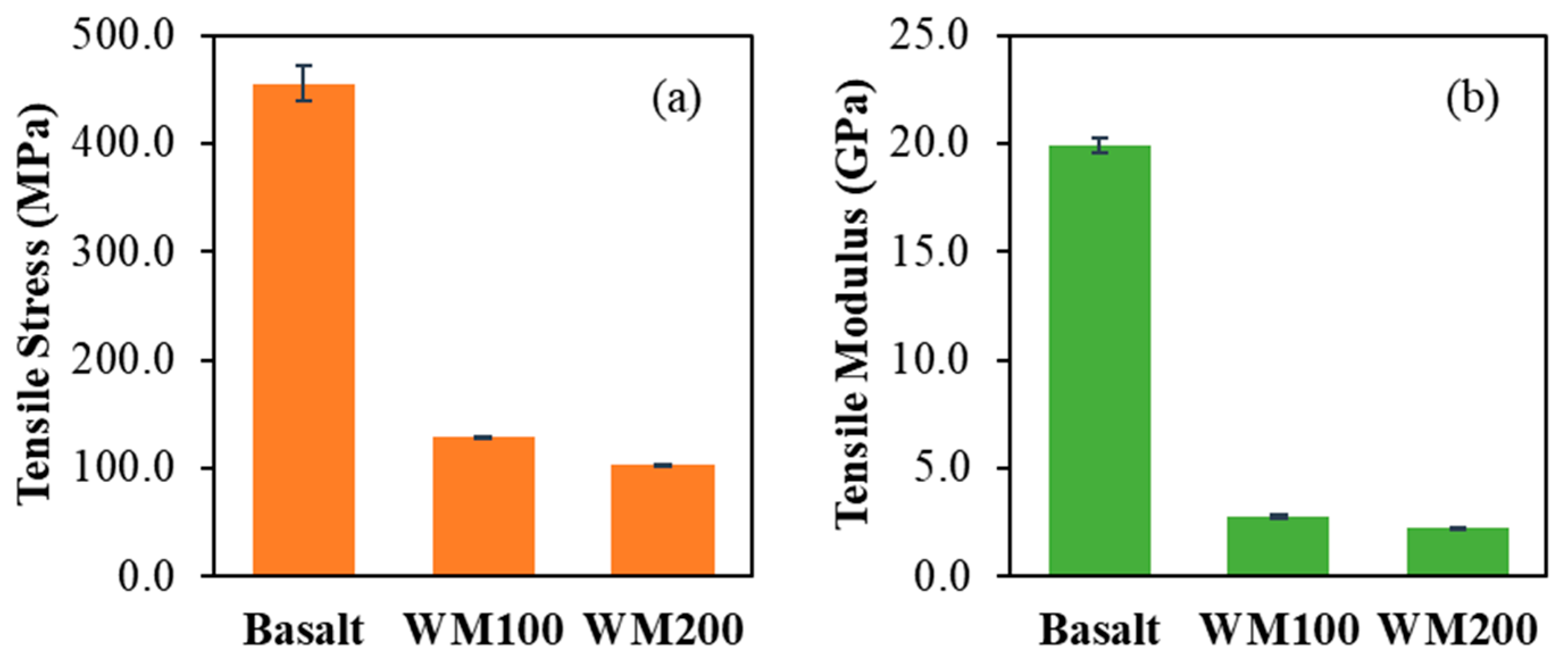

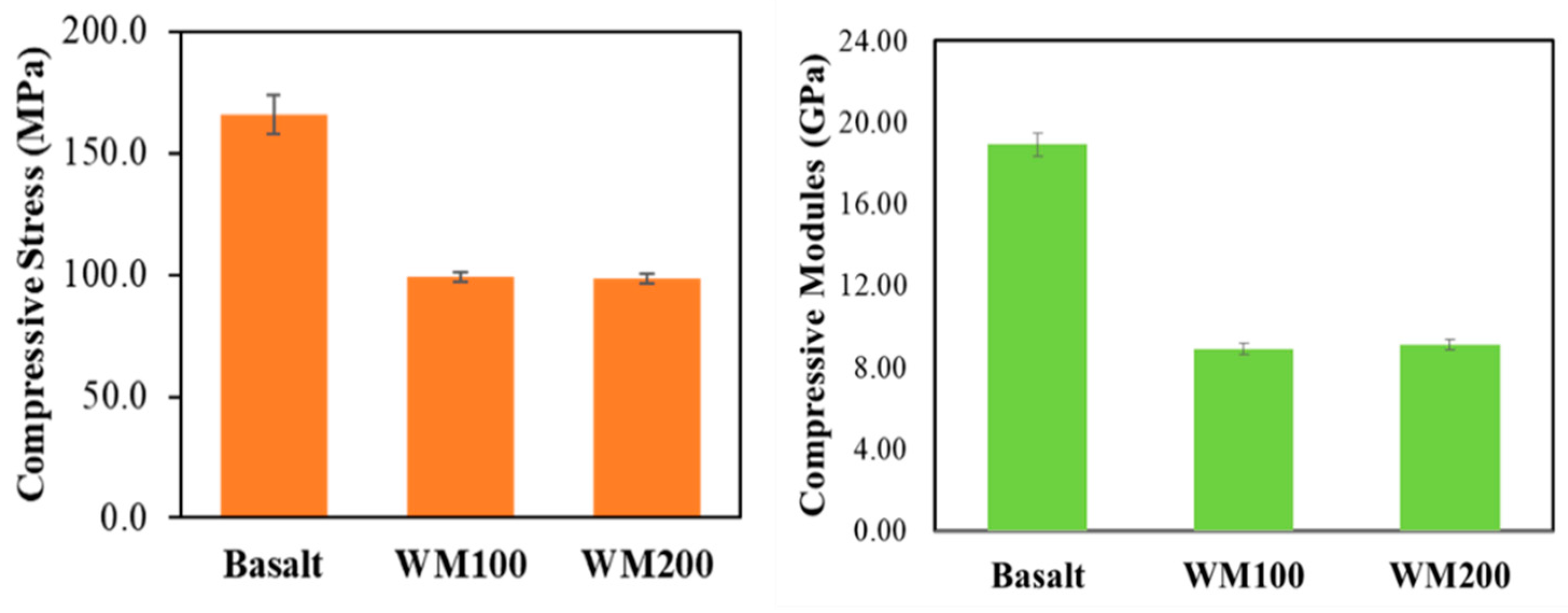


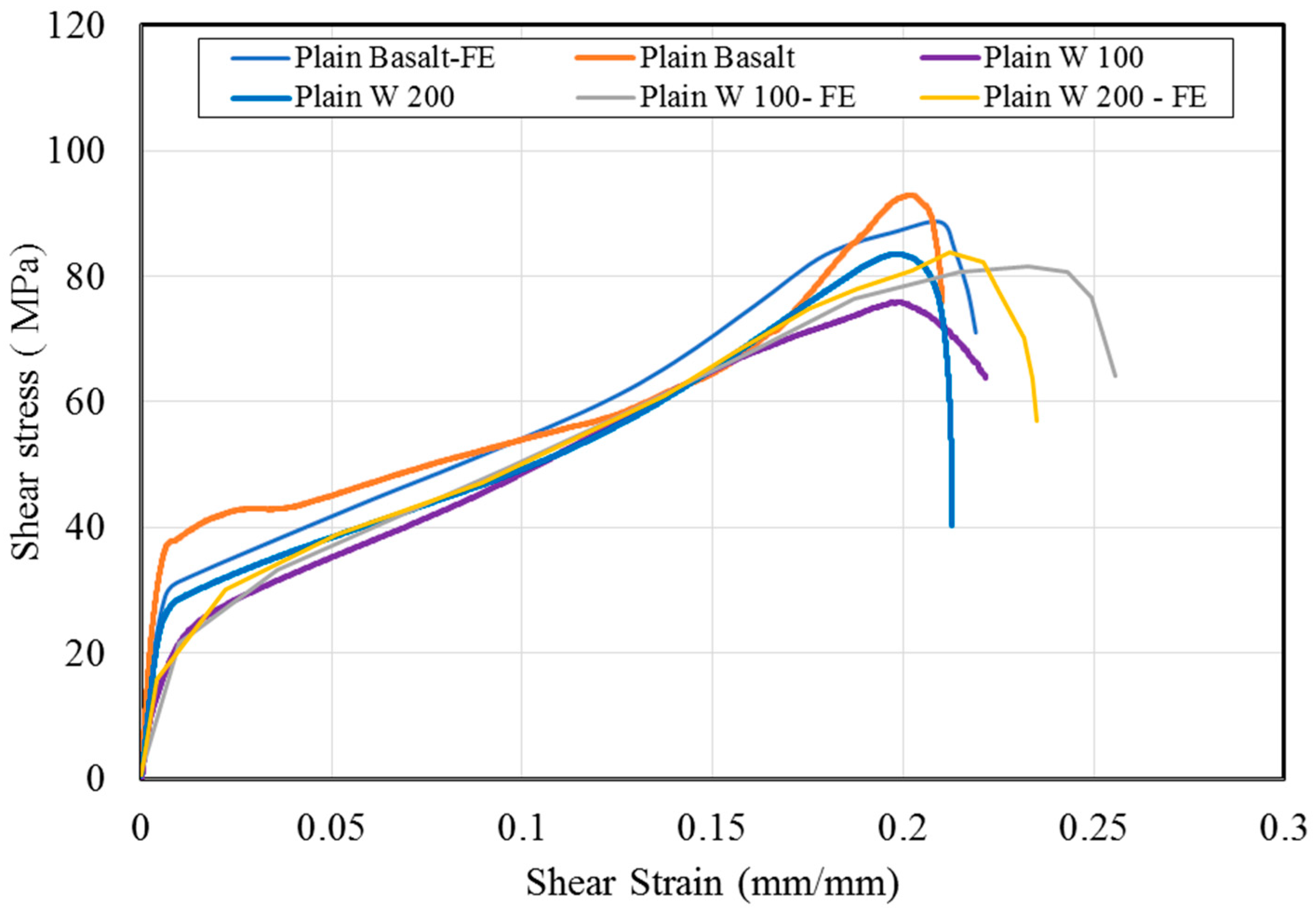




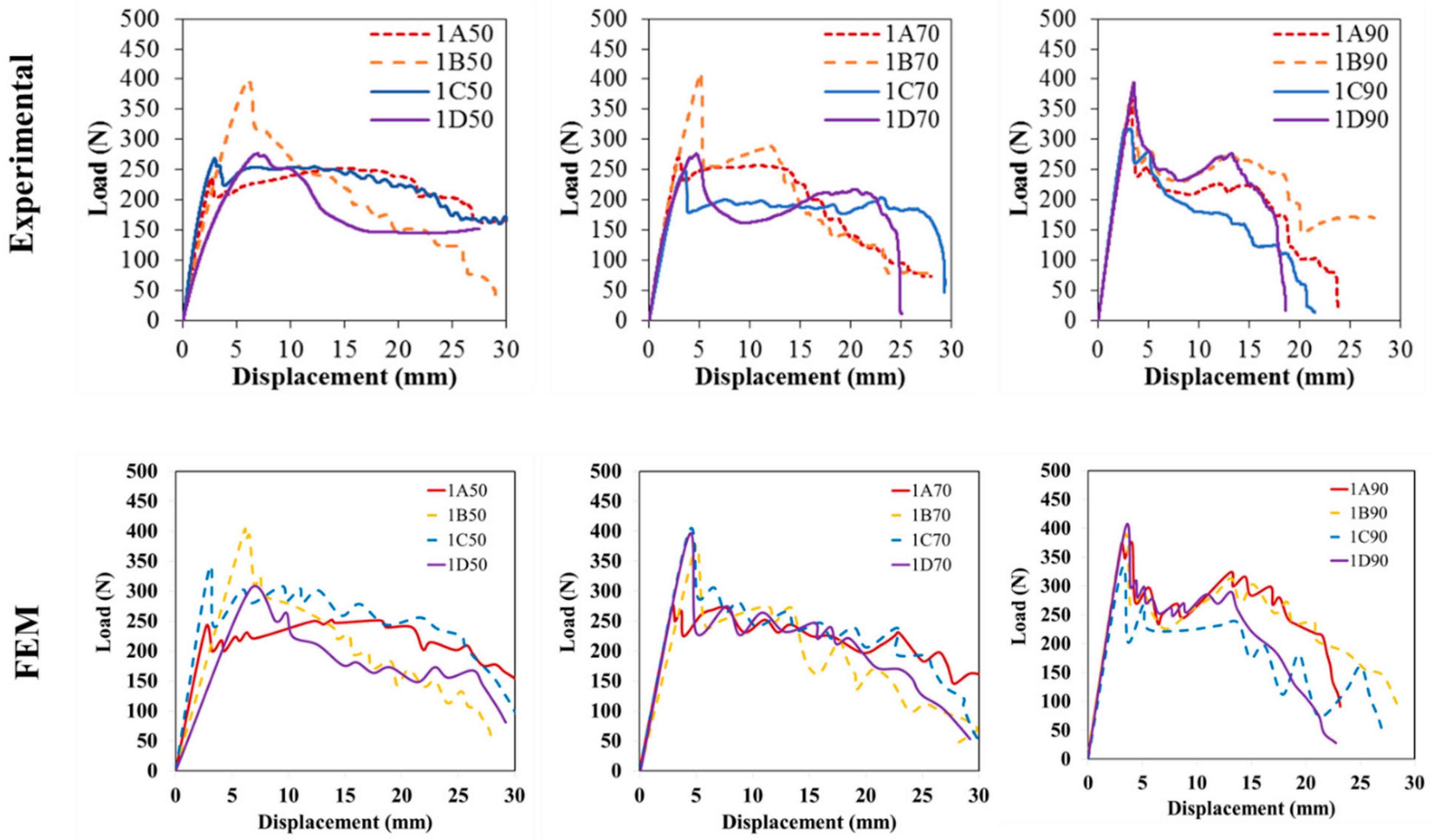
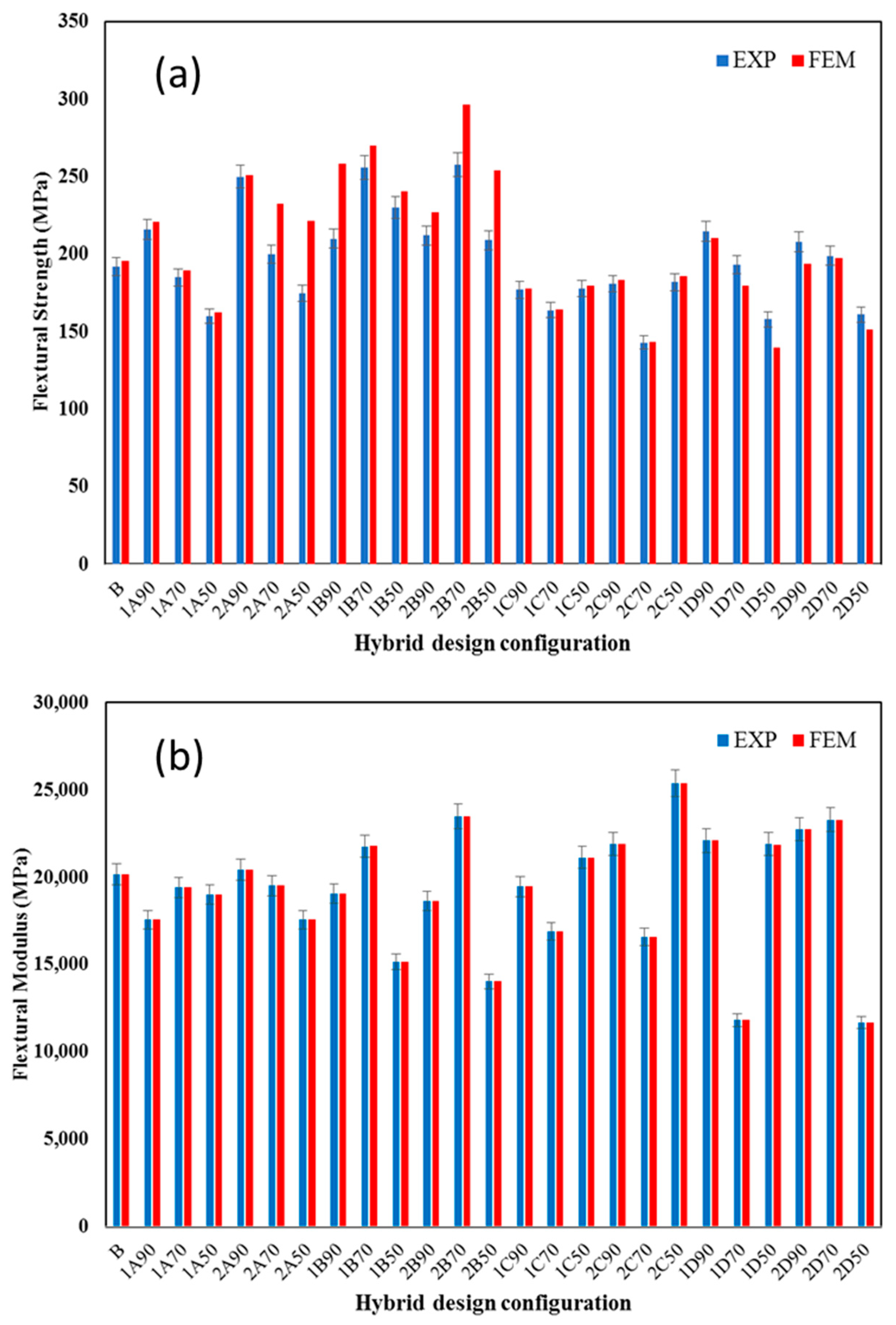
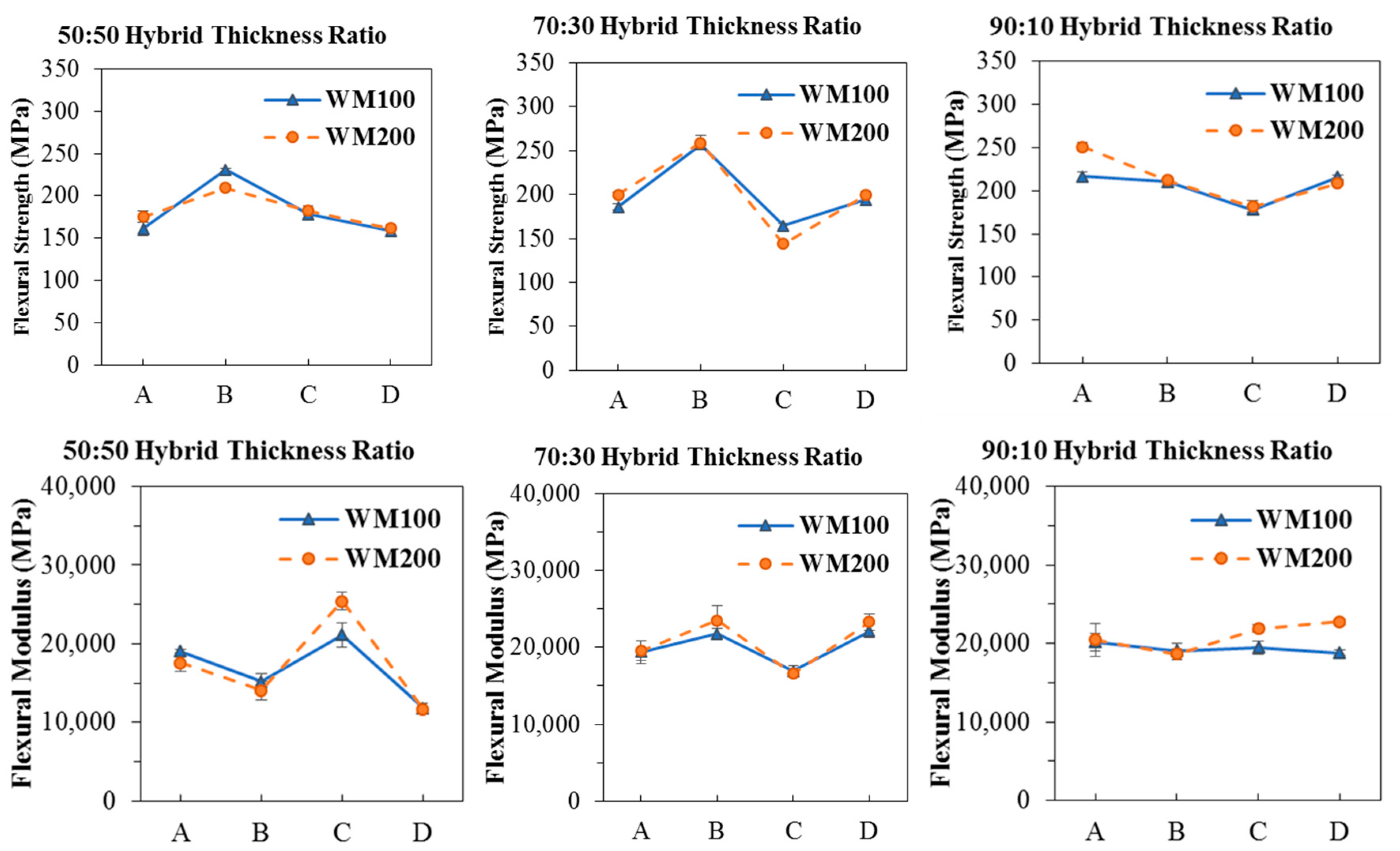

| Type | Mesh Densities (Mesh Number) | Wire Diameter (mm) | Aperture Size (mm) | Open Area (%) |
|---|---|---|---|---|
| 1 | 100 | 0.1 | 0.154 | 36.76 |
| 2 | 200 | 0.05 | 0.07 | 36.76 |
| DER 331 Epoxy Resin | Description |
|---|---|
| Type | DGEBA |
| Epoxide Equivalent Weight | 182–192 |
| Viscosity@25 °C | 11,000–14,000 |
| Density (25 °C, g/cm3) | 1.16 |
| Jointmine 903 hardener | |
| Viscosity@25 °C | 200–400 |
| Thin Film Set Time (@25 °C) | 5 h |
| Hardness (Shore D) | 85 |
| Sample Designation | Number of Layers | Fiber Volume Fraction (%) | |||
|---|---|---|---|---|---|
| Basalt | Wire Mesh | Basalt | Wire Mesh | Total | |
| B | 24 | - | 47.120 | - | 47.120 |
| WM100 | - | 20 | - | 38.482 | 38.482 |
| WM200 | - | 38 | - | 32.797 | 32.797 |
| 1A90 | 22 | 2 | 44.175 | 3.041 | 47.215 |
| 1A70 | 16 | 6 | 34.513 | 9.528 | 44.041 |
| 1A50 | 12 | 10 | 25.373 | 15.429 | 40.802 |
| 2A90 | 22 | 4 | 44.213 | 3.207 | 47.420 |
| 2A70 | 16 | 12 | 34.616 | 9.716 | 44.332 |
| 2A50 | 12 | 18 | 26.804 | 15.673 | 42.477 |
| 1B90 | 22 | 2 | 45.668 | 3.632 | 49.299 |
| 1B70 | 16 | 6 | 34.361 | 9.463 | 43.824 |
| 1B50 | 12 | 10 | 25.779 | 15.663 | 41.442 |
| 2B90 | 22 | 4 | 44.708 | 3.141 | 47.849 |
| 2B70 | 16 | 12 | 36.117 | 10.080 | 46.197 |
| 2B50 | 12 | 18 | 25.310 | 14.600 | 39.910 |
| 1C90 | 22 | 2 | 46.037 | 3.767 | 49.804 |
| 1C70 | 16 | 6 | 34.936 | 11.612 | 46.547 |
| 1C50 | 12 | 10 | 25.128 | 18.691 | 43.820 |
| 2C90 | 22 | 4 | 45.904 | 3.159 | 49.063 |
| 2C70 | 16 | 12 | 35.708 | 10.298 | 46.005 |
| 2C50 | 12 | 18 | 26.573 | 15.444 | 42.017 |
| 1D90 | 22 | 2 | 44.573 | 2.905 | 47.478 |
| 1D70 | 16 | 6 | 36.562 | 11.996 | 48.557 |
| 1D50 | 12 | 10 | 24.515 | 18.632 | 43.147 |
| 2D90 | 22 | 4 | 46.635 | 3.261 | 49.896 |
| 2D70 | 16 | 12 | 34.326 | 9.830 | 44.156 |
| 2D50 | 12 | 18 | 26.376 | 15.132 | 41.508 |
| Run | Factor 1 | Factor 2 | Factor 3 |
|---|---|---|---|
| A: Thickness Ratio | B: Mesh Density | C: Layer Config | |
| 1 | 50/50 | 100 | B |
| 2 | 90/10 | 200 | A |
| 3 | 90/10 | 200 | B |
| 4 | 70/30 | 100 | B |
| 5 | 50/50 | 200 | C |
| 6 | 90/10 | 200 | D |
| 7 | 90/10 | 100 | C |
| 8 | 90/10 | 100 | A |
| 9 | 70/30 | 200 | B |
| 10 | 50/50 | 100 | C |
| 11 | 70/30 | 200 | D |
| 12 | 90/10 | 100 | D |
| 13 | 90/10 | 200 | C |
| 14 | 50/50 | 200 | A |
| 15 | 90/10 | 100 | B |
| 16 | 70/30 | 100 | D |
| 17 | 70/30 | 100 | C |
| 18 | 50/50 | 200 | B |
| 19 | 70/30 | 200 | C |
| 20 | 70/30 | 100 | A |
| 21 | 50/50 | 200 | D |
| 22 | 50/50 | 100 | A |
| 23 | 50/50 | 100 | D |
| 24 | 70/30 | 200 | A |
| 25 | 100% Basalt | --- | ---- |
| 26 | 100% steel wire mesh | 100 | ---- |
| Properties | Description | Basalt/Epoxy | Steel Wire Mesh/Epoxy 100 | Steel Wire Mesh/Epoxy 200 |
|---|---|---|---|---|
| Density (kg/m3) | 1600 | 2300 | 2280 | |
| Young’s modulus in the longitudinal direction (GPa) | 19.9 | 2.8 | 2.3 | |
| Young’s modulus in transverse direction (GPa) | 19.9 | 2.8 | 2.3 | |
| Poisson’s ratio | 0.29 | 0.3 | 0.3 | |
| In-plane shear modulus (GPa) | 2.7 | 1.91 | 2.31 | |
| Out-of-plane shear modulus (GPa) | 2.7 | 1.91 | 2.31 | |
| Longitudinal tensile strength (MPa) | 455 | 128 | 102 | |
| Longitudinal compressive strength (MPa) | 455 | 128 | 102 | |
| Transverse tensile strength (MPa) | 120 | 78 | 76 | |
| Transverse compressive strength (MPa) | 120 | 78 | 76 | |
| Shear strength (MPa) | 100 | 91 | 89 |
Disclaimer/Publisher’s Note: The statements, opinions and data contained in all publications are solely those of the individual author(s) and contributor(s) and not of MDPI and/or the editor(s). MDPI and/or the editor(s) disclaim responsibility for any injury to people or property resulting from any ideas, methods, instructions or products referred to in the content. |
© 2024 by the authors. Licensee MDPI, Basel, Switzerland. This article is an open access article distributed under the terms and conditions of the Creative Commons Attribution (CC BY) license (https://creativecommons.org/licenses/by/4.0/).
Share and Cite
Bin Salim, M.Y.; Farokhi Nejad, A.; Yahya, M.Y.; Dickhut, T.; Rahimian Koloor, S.S. Mechanical Characterization of Hybrid Steel Wire Mesh/Basalt/Epoxy Fiber-Reinforced Polymer Composite Laminates. J. Compos. Sci. 2024, 8, 184. https://doi.org/10.3390/jcs8050184
Bin Salim MY, Farokhi Nejad A, Yahya MY, Dickhut T, Rahimian Koloor SS. Mechanical Characterization of Hybrid Steel Wire Mesh/Basalt/Epoxy Fiber-Reinforced Polymer Composite Laminates. Journal of Composites Science. 2024; 8(5):184. https://doi.org/10.3390/jcs8050184
Chicago/Turabian StyleBin Salim, Mohamad Yusuf, Ali Farokhi Nejad, Mohd Yazid Yahya, Tobias Dickhut, and Seyed Saeid Rahimian Koloor. 2024. "Mechanical Characterization of Hybrid Steel Wire Mesh/Basalt/Epoxy Fiber-Reinforced Polymer Composite Laminates" Journal of Composites Science 8, no. 5: 184. https://doi.org/10.3390/jcs8050184







